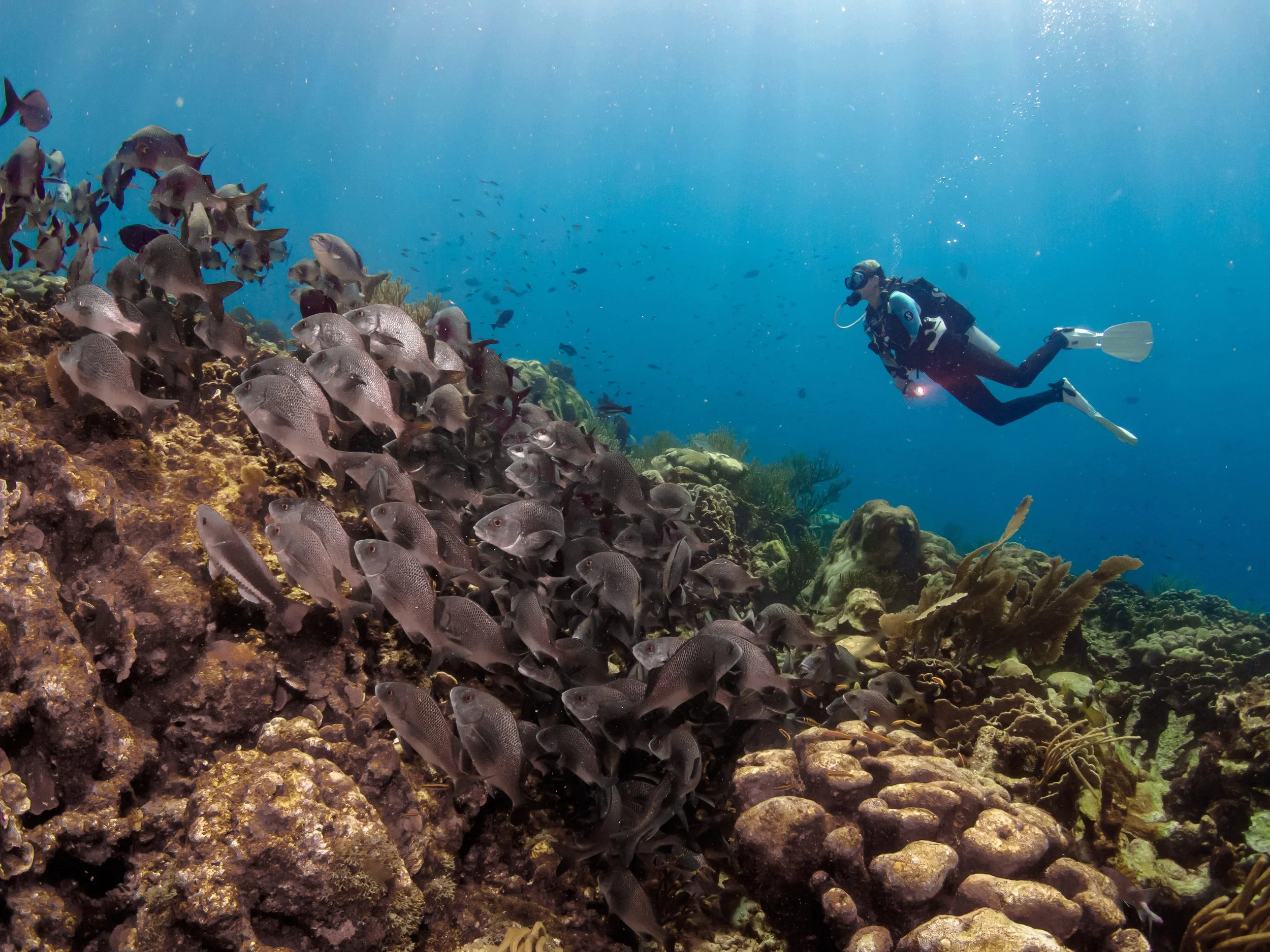Not Just Rocks: Coral Behavior 101
If you think corals just sit there looking pretty, think again. These underwater architects of the Caribbean are anything but static. From moonlit mass spawnings to slow-motion turf wars, Bonaire’s corals are full of surprises—if you know when and where to look. Whether you're snorkeling the shallows of Something Special or gliding along the reef wall at La Dania's Leap, there’s a whole hidden world of coral behavior happening right under your nose (or mask).
Staghorn corals are also essential reef builders.
Hard corals are the architects of the reef, and their foundations are built in calcium carbonate. Each tiny polyp secretes this hard limestone material beneath itself, slowly stacking new layers over old as it grows. Over time—and we’re talking decades to centuries—these colonies form the massive structures we recognize as coral reefs. In Bonaire’s fringing reef, species like Orbicella annularis (boulder star coral) and Acropora palmata (elkhorn coral) are key builders, providing the literal foundation for the entire reef ecosystem. Their skeletons create nooks and crannies for fish, crustaceans, and invertebrates to shelter, turning the reef into a sprawling, multi-level metropolis of marine life.
Soft corals, on the other hand, don’t build reefs—but they’ve got their own unique tricks. One fascinating behavior? They can retract their tiny polyps when touched or threatened, a subtle defense mechanism against predators and sediment. Some species can even produce chemical compounds to deter fish and overgrowth from other organisms—a kind of slow-motion chemical warfare. Watch closely while snorkeling off the coast at places like Cliff or Bari Reef, and you might notice the sea fans folding inward ever so slightly, responding to your presence.
Coral polyps!
These animals also have a taste for plankton. Yes, even the rock-like hard corals are actually animals, and they’ve got tentacles to prove it. Usually at night, tiny translucent arms reach out from coral polyps to catch plankton drifting by. Brain corals and star corals become all tentacle-y after sunset, looking more like sea anemones than stone. This feeding frenzy is best seen during a dusk or early night dive, when the reef pulses with movement. Bring a red light (which is less disturbing to marine life) and watch the buffet unfold.
Then there's coral spawning, it's like something out of a sci-fi movie. Usually 5–8 days after the full moon in late summer, the reef throws a synchronized party. Corals release bundles of eggs and sperm into the water column in what looks like underwater snow. Depending upon the coral species involved, spawning events can happen only once or few times a year. Temperature, moon phases, and timing of sunset all seem to play a role in determining when different species may spawn. Entire species across the reef often spawn simultaneously—an evolutionary trick to maximize fertilization and overwhelm predators. It only lasts a few hours, and witnessing it feels like you’ve stumbled into a secret ritual.
And don’t let their calm exterior fool you—corals are fierce competitors. Corals aren’t just passive builders of beauty—they can be downright scrappy. Some species wage slow-motion turf wars, extending specialized tentacles called “sweeper tentacles” to sting and overtake their neighbors. Others use chemical warfare, releasing compounds that inhibit the growth of rival species. It’s reef politics at a glacial pace, but with high stakes: more space means more light, more food, and better chances of survival. When you see oddly spaced patches of coral or dramatic borders between species on a dive, you’re witnessing the quiet battles of coral diplomacy.
Another underrated coral superpower? Mucus. Yep, many corals regularly slime themselves in a protective goo. This mucus traps sediment and unwanted microbes, and some species even shed it like a sneeze to keep their surfaces squeaky clean. It may not be glamorous, but it’s a survival strategy that helps them stay healthy in changing conditions. On especially still days, you might even spot the ghostly threads of this mucus drifting off coral heads in the shallows—just one more reminder that the reef is alive and adapting in real time.
Volunteers taking care of coral nurseries, where corals are grown for eventual outplanting as part of reef restoration efforts in Bonaire.
So what can you do to keep these coral oddities thriving? First, be a mindful visitor—wear reef-safe sunscreen, avoid standing or kicking on the reef, and don’t touch anything (even if it looks dead, it’s probably alive). That mucus mentioned above? Even a slight brush of your fins between soft coral branches can remove the protective layer and cause damage. The tentacles the corals feed with are also super delicate and damaged by even the gentlest touch. If you're interested in contributing to conservation, many of Bonaire’s tour guides are trained Reef Renewal volunteers, and some offer “coral gardening” tours where you can learn about—and even help with—restoration efforts. Supporting these programs helps ensure that the next generation of divers and snorkelers get to experience coral magic too. Because once you realize corals are doing stuff, you’ll never look at the reef the same way again.
Contact us to learn more about Reef Renewal diving!




